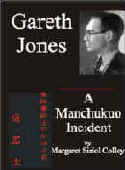Gareth Jones
[bas relief by Oleh Lesiuk]
HOME |
Stop Press |
Complete Soviet Articles & Background Information |
Précis of Gareth's
|
All Published Articles |
BOOKS
|
|
|
|
More Than Grain of Truth(2005) |
|
|
TOPICAL
'Are you Listening NYT?' U.N. Speech - Nov 2009 |
Gareth Recognised at Cambridge - Nov 2009 |
Reporter and the Genocide - Rome, March 2009 |
Order of Freedom Award -Nov 2008 |
Premiere of 'The Living' Documentary Kyiv - Nov 2008 |
Gareth Jones 'Famine' Diaries - Chicago 2008 |
Aberystwyth Memorial Plaque 2006 |
GENERAL
Scholarship Fund |
Site Map |
Links |
Legal Notices |
Sponsored Links |
Contact |
Japanese Influence in Siam |
|
||||||||
by
Gareth Jones
Bangkok, Siam.The
recent Japanese invasion moves in North China have again drawn the
attention of observers in the Far East to plans of Japanese expansion
and the fear is often expressed that Japan is extending her sway not
only over parts of China, but over distant regions such as Siam.
It is a commonplace of club-room conversations that Japanese influence
is spreading so rapidly among the Siamese of the new revolutionary
regime as to endanger Britain’s control over the path from the Pacific
to Asia, and the old Kra Canal rumour, which the Japanese are said to
wish to build a canal through the Isthmus of Kra, thus shortening by
about two days the route between China and India and curtailing the
usefulness of Singapore. This
fear of a Siam dominated by Japan has even led the Times of India to
write on April 11th, 1935: “India has this great interest - that the
establishment of Japanese economic hegemony ever Siam would bring a new
international influence into an area which is contiguous with the
frontier of Burma. In the past India’s foreign and defence
policies have been dictated by considerations of the risk attaching to
the North West frontier, where first the Russian menace and later, the
Afghan unrest were present. Should a new militant power establish
itself on the eastern border of Burma India’s foreign and defence
policies will need radical revision.” A
problem, which is capable of changing the whole military and foreign
policy of India and of costing Britain many millions of pounds in
defence schemes, needs careful consideration. During a stay in
Siam I heard the views of the leading foreign and Siamese authorities on
the problem of Japanese influence and for the reasons I shall set down,
I came to the conclusion that Japanese control in Siam is a myth; that
Japanese penetration has been greatly exaggerated and that while there
are many signs of a rapidly growing friendship between the Siamese and
the Japanese, talk of building of the Kra Canal and of Japanese
domination of the route India is little more than sensational smoke room
gossip. The
nationalism, which inspires the present rulers of Siam, is not of a
type, which would allow them to abandon their control of affairs to
Japanese and for reasons of personal power and sensitiveness. They
are jealous of their grip over politics; “Siam for the Siamese is a
far more potent slogan than “Asia for the Asiatics”, and while there
are some supporters of “Pan Asianism” the vision of most young
Siamese is still limited to their own fatherland. Strategic
reasons such as their wedged-in position between British territory,
British Malaya and Burma, and French Indo-China prevent the Siamese
rulers from placing too great strategic stress on Japan many thousand
miles away. Within
Siam there is a large Chinese population, powerful in its control over
business life, which would lead the Siamese to hesitate in adopting
too readily Japanese advice. In spite of’ the usual absence of
national feeling among Chinese and of their disregard of what happens
away from their own province, there was a considerable boycott of
Japanese goods by Chinese in Bangkok, and Chinese servants in some
British and American families were known break any Japanese crockery
they found in their master’s houses. In
informed circles alarm about the building of the Kra Canal is held to be
unjustified, and rather humorous. It would be impossible to raise
the capital in London or New York for such a great undertaking, while
Tokyo even if it were a great monetary centre has too many financial
problems at home and in Manchuria to be able to spare money for the
Canal. Should the unlikely occur and the Canal be built, the dues
would be so heavy that few shipping companies would use the Canal in
order to save two days voyage, and take a route which would make them
lose many valuable freights in the rich free-trade entrepot of
Singapore. The Kra Canal is thus dismissed with a gesture of
amusement by reliable observes in Singapore and Siam. Finance
is a final barrier to Japanese control over Siam. There have been
British financial advisers since 1896 and the Siamese currency is linked
to sterling. Siamese financing is centred in London and there is
little likelihood of the Siamese rulers exchanging the solid rock of
City support for the shifting sand of a Yen backing. While
the scare a Japanese grip over Siam may be dismissed as sensational,
there is no doubt about the growing friendship between Siam and Japan.
Young Siamese look with respect upon the achievements of the rising
Asiatic island empire and say: “We want to be the Japan of the
South.” A leading Japanese official in Bangkok said to me:
“The Siamese regard Japan as an elder brothers. To them Japan is
an example of a country that has freed itself and is progressing
rapidly. We are, however, not a leader but a mentor and it is
right that we play a big part among the Asiatic peoples. Thus the
youth here say: “If only we could do what the Japanese have done.” In
the last two years there has been an increase in the intercourse between
the Nations, due largely to the cheapness of Japan. A number of
students have gone to Japan to study and find that the travel1ing
expenses, university fees and the cost of living are lower than in
Eng1and. Thus a Siamese student can study for a year in Japan
including travel for rough1y £120, while a year’s study at a British
University, including travel, will cost at least £300. The
depreciated yen has been a most important link between Siam and Japan
leading to an increase of travel between the two countries. Japan
has received this year a Siamese parliamentary commission, while prison
experts from Bangkok and elsewhere have studied Japanese treatment of
criminals. Abandoning the tradition that Britain shall train the
young naval officers of Siam, the Siamese Government has this year sent
a number of naval cadets for training in the Japanese fleet. Race
and religion are other bonds between the two peoples, which are both
Buddhist. The Siamese, while first and foremost nationalistic,
are none the less growing conscious of being Asiatic, and the Siamese
Expeditionary Force witnessed in France during the War the spectacle of
a Europe of blood and. hunger. There has been a decline,
therefore, in the esteem paid to Europeans and a decrease in the Western
experts. The Siamese State railways, which formerly had many
British experts and foremen has today, I was told, only one British
employee. Japanese experts are increasing although there is no
Japanese of the rank of adviser. Japanese cotton experts have
been engaged and there are Japanese officers in the Siamese Army.
Another sign of friendship is Siam is that refrained from the vote
against Japan at the League of Nations meeting, which condemned
Japan’s action in Manchuria in March 1933. Siam was alone in her
refusal to vote. Moreover the news agency, which mainly supplies
the Siamese newspapers, is the official, Japanese agency, Rengo; a fact,
which tends to increase the stress laid upon Japan’s importance.
It
is in trade, however, that Japan is advancing in Siam. Imports
direct from the United Kingdom declined from l22, 750,000 bahts
(approximately 11 bahts to a £) in 1932 to l0, 866,675 bahts in 1934,
while Japanese direct imports increased from 5,850,000, bahts in 1932
(the year of the Chinese boycott) to I4, 648,969 bahts in 1934. In
1929-30 British imports into Siam were more than double the imports from
Japan to Siam. By 1934 Japanese imports had exceeded British
imports. To illustrate the advance of the Japanese in textile
imports the statistics on singlets are revealing. In year 1932-3
Japan imported 1,725 dozen singlets, while the next year she imported
105,049 dozen singlets into Siam. (These figures omit the Japanese goods
imported from Singapore and Hong Kong and from the Japanese owned mills
in China. Siamese trade figures are so complex, however, that it
is dangerous to rely too thoroughly upon them. The general fact
stands out that Japan is going ahead rapidly: has surpassed Great
Britain as a supplier of Siam and now is the main source of the imports
of cotton goods, wireless accessories, cement, bicycles, paper,
artificial silk, silk and some other goods. A store selling
Japanese “Datsun” cars at a lower price than the Austin Seven
has been opened in the main street of Bangkok: a sign that Japan is
entering into the Motor car export trade, although last year she
imported only one car into Siam. Japanese bicycles imported into
Siam in 1932-3 numbered 947, while one year later they numbered 5,246
compared with 469 British bicycles in the later year. A few months
ago Japanese contractors were given large orders for railway bridges in
the face of serious competition from number of European firms. Friendly
though the social and trade relations between the two countries may be
growing it would be rash, however, to leap to the facile conclusion that
Japan dominates Siamese policy. The new nationalist regime is not
likely to throw itself into the arms of a foreign government. |
GARETH JONES (1905 -35) |
||||||||
|
|||||||||




